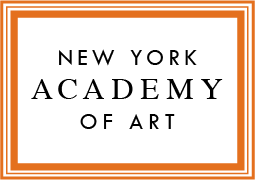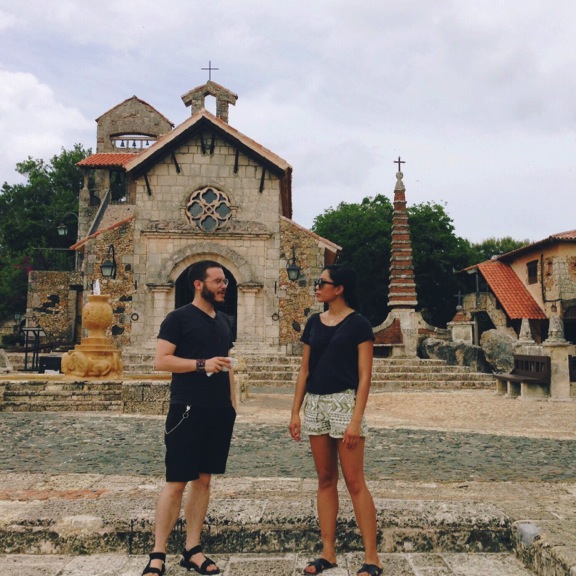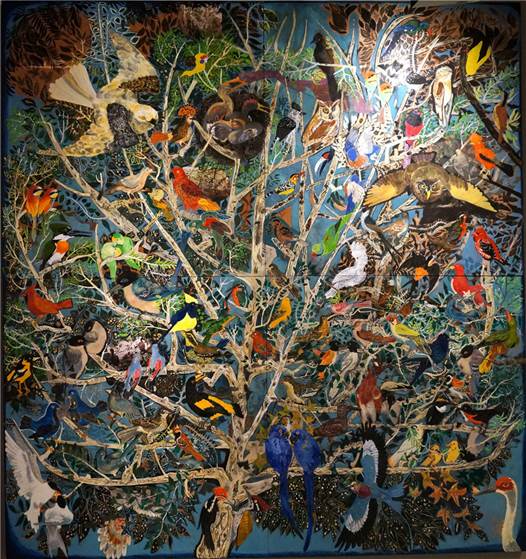All Day Brunch, Improv Tea Ceremonies, and Green Onions For Free
 |
| Polly at Belencre |
 |
| Drinking tea at our studio |
 |
| My studio mate Zai Zhou |
| Clay shop one hour away from Beijing |
 |
| Funny restaurant names |
Xie xie and Green Onions for Free!!
 |
| At our exhibition opening |
Emily Davis Adams – Dumfries Residency
Emily Davis Adams (MFA 2011, Fellow 2012) just completed the “Dumfries House Residency,” at Dumfries House, in Scotland. Dumfries House was built between 1754-1759 for the 5thEarl of Dumfries, and is set on 2,000 acres of land in East Ayrshire, Scotland (about an hour’s train ride South of Glasgow). The estate’s principal rooms and their contents have remained almost completely intact for 250 years, leading to a description of Dumfries House as “an 18th century time-capsule.”
 |
| A Path on the Estate |
 |
| Close-up of Emily’s Palette |
How has your work progressed since your NYAA postgraduate fellowship?
 |
| “Buttonwillow” – from Emily’s NYAA years |
 |
| Moss Covered Specimens in Emily’s Studio |
 |
| View from the Studio Window
### |
St Peterburg: A Spiritual Labyrinth
Today I write a story, without much to say, like a room full of forgotten memories: an irrelevant story, the kind that doesn’t stay for long time. A static story, where the dust keeps accumulating and the insects fly with apathy.
I start this story, on a rainy summer day, that type of rain that does not soak you; it just creates a desire of cleanliness that perhaps would never occur. So, you start your journey looking for occasionally refuge in street alleys whose existence you did not recall, you immerse yourself in the city and you start to forget the main avenues, you stop seeing the beautiful ornaments that embellish the buildings and you exchange the powerful façades with windows falling apart and rusty irons that at some point were marveled at by curious child. The rain falls slowly in this city obsessed with the accumulation of unimportant objects. Like this sad story, hundreds of banal objects are on display in old showcases, observed objects by millions of souls that no one would remember; objects without any practical function, some less dusty than others, one thousand different materials and without any clear message to give except the awareness of how meaningless we are.
And like a cheap magic trick, your soul is worthless compared with a 70’s soviet toy; soviet in the terms of fairytale where instead of seeing some rotten plastic by the sun, you see the possibility to connect with a world that will never belong to you. Soviet tools, soviet glasses, soviet bottles, soviet paperweight, soviet mold, soviet deleterious vapors, soviet dreams rooted to plastic spoons that one day someone would tell their grandchildren about the era he never grew up in but they would be convinced of the contrary. And his grandchildren would tell the fantastic stories with such certainty about their soviet grandpa that use to be young at the beginning of XXI century until the day that someone would destroy their wonderful memories with a simple world history book. That is the moment when you create the illusion of going back home and tell all about those stories that never exist, discovering useless objects that maybe you should buy. Meanwhile, you keep your breath away from the sulfuric, dense air, you remember the last days where you imagined all those princesses with huge dresses running through the millions of hallways in a palace where the opulence falls in the grotesque.
You recalled the one and thousand rooms without any purpose, where you can pass months without finding the exit or any other broken soul in the way. You inquire if in those small windows one could contemplate the ancient woods where you can find those monsters that crawl into your nightmares. You wonder if in this shiny palace there a way to find a cosmic connection, elevate your spirit to such a level that would not be necessary to create artifacts to land to the moon. Suddenly, you realize that for those princesses one palace was not enough, so you start doubting if they had the enough time to explore all the chambers of those palaces built by their parents, between extravagant hairstyles and dresses that were the home of more than one crawling creature, the simple idea of running princesses make you laugh.
After a short mind absence, you are still there in the antique shop where a rotten pot has an exorbitant price but as soon you leave the place, you are paying 75 rublos (1.50 US dollar) to see some domestic porcelain, that kind of porcelain that reminds you of your grandma’s house. The same that reminds you of the worst nightmares, your childhood is back when if you dare to look such fragile ornaments, they would break apart and that would mean, hours of insufferable labor work or just staring at a white corner for hours. And there you are, at your adult age paying to see the similar porcelain that you used to hate and you wish to destroy right now with your bare hands. You limit your thoughts by looking to the wonderful painted ceilings and you wonder again, where are hidden the treasures that enlighten our spirits? How do you give any importance to your spirit when the world is collapsing?
You try, in the middle of the city where the palaces vomit gold and the neighborhoods spit the excess of filthy odors, to find sense and try to not drown yourself in a canal, questioning the necessity of becoming another person creating obsolete objects.
You try to decide whether or not believe in daily miracles or give a chance a throw a coin in a rebuilt fountain or pray in a church which for decades was a milk factory, meanwhile your small and fragile mind tries to comprehend how a city relatively young has been modified so many times in order to fulfill its masters’ desires that makes the city something so unique. Because how many places do you know that they build thumbs in the form of churches, or they build churches that had never fit that purpose, where in decades they destroy all the churches and in less than one they rebuild them and make bigger and more powerful ones, where the city is consider beautiful not because their Russian roots but because it resembles some city from Europe, where you pay the same price to see some old unimportant porcelain and some da Vinci masterpiece and where you pay to enter a cemetery where you start a conversation whether Tchaikovsky or Dostoyevsky is more important, and at the end you wonder why no one ever mentions Tolstoy. There you are with all your hopes to find something truthfully magic, without any kind of tags or wondering if it is old or not, you just want to marvel of that far away land that dreamed when you were a child, a place where you can feel that you are not so worthless.
Standing on a roof you observe the city, with a brilliant effort you start to recognize the original buildings and the ones recreated recently, the eternal sunset penetrates that soul that you thought was in danger of extinction.
You imagine the extraordinary live of the whimsical clouds traveling as fast as they can telling the stories that not even your ancestors heard and then you walk into a non-particular room, your eyes glow and everything makes sense. Your spirit at last is been fed.
Altos de Chavon: An Open Mind is Essential For Growth
This is my second week in Altos de Chavón, and I am amazed how beautiful this place is! Jess Leo (MFA 2015) and I arrived during Alex Smith (MFA 2015) and Andres de la Torre’s (MFA 2015) last week of their residency. They helped us get acclimated to the new environment, taking us on various day trips and giving us advice based on what they experienced here. It was comforting to see their familiar faces.
Now that Alex and Andres have left, I am excited to see how our residency will differ from theirs and how Altos de Chavón will affect our work. Jess and I will no longer be teaching separate classes like we thought. Fortunately, we were able to plan a one-week intensive workshop scheduled for next week combining painting, collage and woodblock printmaking.
Since neither of us have done it before, Jess suggested to recreate one of my collage paintings into a woodblock print. So far, I have drawn the image on to a block and carved into it. I can’t wait to start printing! The scenario forced us to backtrack, but it forced me to be more open-minded about the outcome of my work.
Lenin’s Body, Space Dogs, and Saint Petersburg
Impressions of Istanbul
Leonid Lerman serves as adjunct faculty at the New York Academy of Art and participated as the visiting critic for the Academy’s Istanbul residency this summer.
 |
| Image courtesy of Austin Lopez |
I’m not much of a blogger, but feel like briefly sharing with you some of the impressions of the last few days. I’m slowly falling under the spell of Istanbul – walking a lot every day through the labyrinths of the small streets – I feel myself inside of a living sculpture. The experience reminds me my youth, spent in Odessa, life in the presence of a sea, lots of sun, great food and loud, happy and generous people. Nostalgic…
Two days ago spent an afternoon at the Istanbul Modern. Walking out at the end of the day I saw a large crowd of a young people listening to a man, speaking English with a heavy accent. Coming closer I recognize Slavoy Jijeck, cultural philosopher, speaking on many subjects, including art and politics. It was great, unexpected and very entertaining.
Yesterday at breakfast bumped into two Italians on the way to India, one of them a filmmaker. We shared a meal, had a wonderful conversation and parted friends. Why, it feels so good to see such down to earth, authentic people that you connect to so easily.
I’ve seen a lot for the last three days and looking forward to see and experience more…
Who knows what may come out of it… Not thinking about it but keeping my eyes, ears and mind open…
Will meet Daniel and probably some other students later today, in the afternoon. Time to fulfill the duty, but I’m looking forward to that and will do it with pleasure!
Till next time,
Cheers,
Leonid
Captivated by Istanbul
Whether it is making friends at cafes, seeing historical structures, visiting museums and galleries, or creating art at Mimar Sinan, the residency here in Istanbul has created a source of inspiration in me that could last a lifetime.
Beijing Residency: Inspiration Right Around the Door
Inspiration is right around the door from my studio here at the Central Academy of Fine Art. I’ve spent a good deal of time walking around the CAFA Art Museum looking at the current exhibition. I find myself amazed by the wide variety of student work displaying the best of each department here at CAFA. I hope to go back once more before heading home to New York, because it’s very inspirational to view the work of other students. This show definitely sets the bar high and gets me excited for my class’ graduation show next summer.
As a major exhibition of the year, the exhibition features the selected works of 146 graduates of the master or bachelor’s degree from the School of Chinese Painting, School of Plastic Arts, School of Experimental Art, School of Design, School of Architecture, School of Urban Design and School of Humanities, through a strict academic assessment and careful selection. All participating students are highly innovative and curiosity, not only the graduates of CAFA, but also the hope for the future development in Chinese art circles. Through these works we can clearly see the current standards of teaching of CAFA, as well as the achievement of the stage.
“The Start of a Long Journey” has attempted to boldly breakthrough the traditional inner exhibition mode of an academy, after seven years of developments it has been successfully extended to the whole country, and becomes an important brand of academic exhibition of CAFA. 2015 is the first year for CAFA to bring about a comprehensive exhibition of “Graduation Season,” in a panoramic way it showcased the achievements by the graduates from all the disciplines at CAFA.
Text by Yu Ya, translated and edited by Sue/CAFA ART INFO
The following photos are of the CAFA Art Museum and current graduate show.
From Russia with Love
Our time here in Moscow has been quite a trip! It seems only a couple weeks ago that we arrived in this mysteriously orthodox city. Our days have been filled with plenty of sight-seeing. Stunning architecture, such as the “onion domed” churches, seems to lie around every corner. And centuries old palaces like the one at Kolomenskoye, where President Putin spent his childhood summers.
In addition to this amazing architecture, we’ve also been exposed to some great art at museums like the Pushkin Museum and Tetryakov Gallery, where we’ve discovered some great works of Russian art.
But with so many sights, it’s important to take a break and relax a bit like the locals. Yes, we’ve had a few drinks here in Moscow. On one evening, our hosts took us to a rooftop party with pyrotechnics, kindly celebrating American Independence Day, which happened earlier this month.
Another popular pastime in Russia is ping pong—what fun!
Contrary to popular belief, Muscovites are really very warm and friendly people.
Moscow is a very beautiful city and the people, extremely kind and welcoming. Our guides Sonia and Masha have been extraordinary, introducing us to their many friends and revealing the special places in Moscow that they love. We’re so grateful for their hospitality and for host Nikolay Koshelev for arranging our stay and studio accommodations. Spasibo!
Visit to Artists’ Studios and Museums in Istanbul
In conjunction with studio time, Ali has been giving us private tours of Turkish artists’ studios and museums. His visits have been enriching and engaging. The conversations have been related to Turkish social climate in relationship with art, politics and religion. Each visit has been unique to a particular artist but the conversation tends to go back to politics and social structure and the fact of making art in that particular context.
The art world in Turkey is young and evolving. Historically, most art collections have been in the hands of the elite. However, within the past years these families have started foundations and museums to make art more accessible to the public. Although these museums are young, the push to expose a variety of artists has created an interesting conversation with the rest of the art world. Pera Museum is great example of Turkey´s evolving culture. The museum’s permanent collection consists of Turkish craft antiquities (ceramics, jewelry, furniture, porcelains, etc.) as well as 19th century paintings, which exposes Turkey’s switch to a more secular acceptance. The juxtaposition of the permanent collections to the revolving contemporary exhibitions further exemplifies Turkey´s desire to be a part of the global art conversation.
| Didem Unlu´s studio |
| Beysa Boynudelik´s studio |
| Sultan Ahmed III Receiving a European Ambassador, Jean-Baptiste Vanmour. Oil on canvas, 1725. Pera Museum |
| Tortroise trainer, Osman Hamdi bey. Oil on canvas, 1906. Pera museum. |
| Grayson Perry´s exhibition at Pera Museum |






































